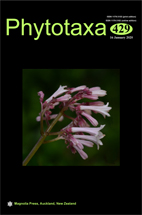Abstract
Veltheimia is a genus of two species of bulbous flowering angiosperms restricted to southern Africa. Both parsimony and Bayesian analysis of 1829 nucleotides of DNA sequence data, from three non-coding chloroplast regions from multiple samples of both species, indicates that specimens of V. bracteata form a monophyletic clade together with three specimens named as V. capensis. This clade receives low support and is embedded within a paraphyletic grade of specimens of V. capensis. A Median Joining Network analysis of a subset of samples revealed nine haplotypes, the relationships of which mirrored the relationships resolved by the Bayesian analysis. With the exception of the V. capensis members of the V. bracteata clade, the remaining specimens are from the summer rainfall thicket and coastal forests. The samples of the basal V. capensis grade are found in the winter rainfall regions of southern Africa. These results indicate that there is limited genetic diversity within the genus, and there is no clear distinction between these two species based on plastid non-coding DNA data. This may be due to their recent divergence and incomplete lineage sorting, or recent or ongoing hybridisation and / or introgression.

